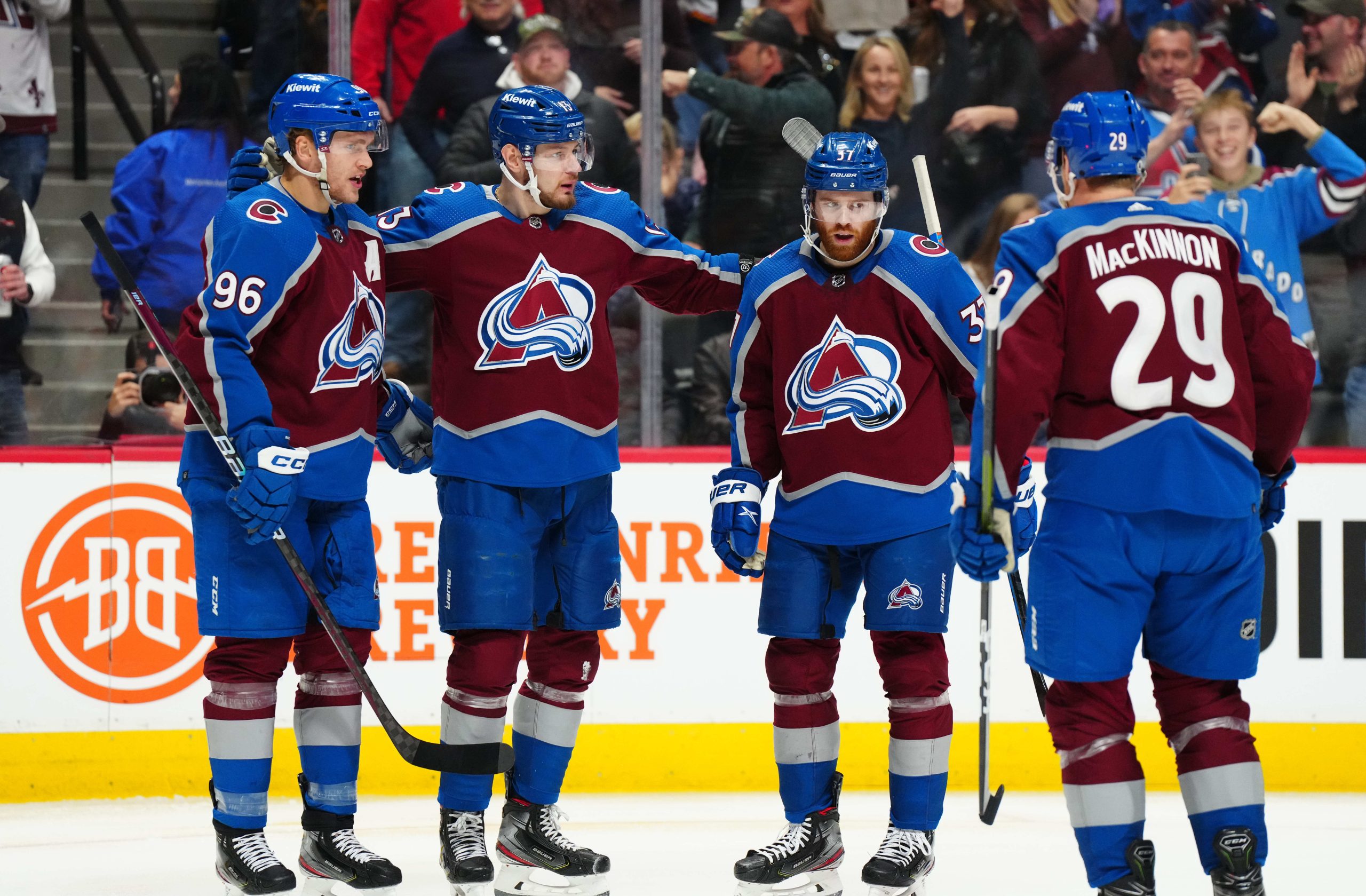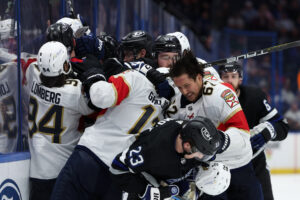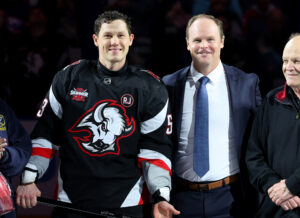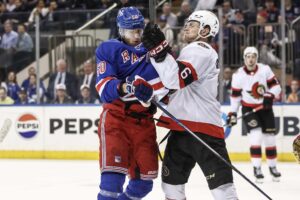NHL player development seems to always result in more questions than answers. How likely is it for a top pick to pan out? What makes a player a “steal”? Last Word On Hockey will be starting a new series on how to properly develop prospects from all different spots throughout the draft. With forwards drafted out of North American hockey leagues between 2005 and 2015, in the first round, covered, let’s shift to forwards drafted out of Europe.
NHL Player Development Of Top-Three Picks From Europe
Main Photo: Ron Chenoy-USA TODAY Sports
In the span of 2005 through 2015, there were 10 players selected within the top-ten out of Europe. Within that grouping, there were two players who made their NHL impacts (15+ games in a single season) in their DY+1 season, or directly following the draft. Those players were Elias Lindholm and Valeri Nichushkin.
In these pieces, Last Word will be using Even-Strength Offence Goals Above Replacement (EVO), Even-Strength Defence Goals Above Replacement (EVD), Wins Above Replacement (WAR) and Goals Above Replacement (GAR). All those analytics come from Evolving-Hockey (paid subscription required).
NHL Player Development Of Elias Lindholm
Lindholm, drafted fifth overall in the 2013 NHL draft by the Carolina Hurricanes, came out of the Brynas organization in Sweden. In his DY-1 season, Lindholm played for Brynas’ under-20 team. He scored 14 goals and 35 assists for 49 points in 36 games, for 1.361 points per game. That ranked third out of the aforementioned 10 European forwards in DY-1 production. The following season, playing in the top men’s league, Lindholm scored 11 goals and 19 assists for 30 points in 48 games, for 0.625 points per game. That ranked fourth out of those same 10 forwards in DY production. He would make the transition to the NHL the following year.
How Lindholm Was Used
In his first professional season, Lindholm would see some time in the AHL. Across six AHL games, he would score one goal and three total points, a modest statline for a young guy in the minors. But, Lindholm would play a vast majority of his season with the big club. In 58 NHL games, Lindholm averaged 14:32 time on ice per game. With essentially a third-line role, Lindholm would produce nine goals and 12 assists for 21 points. His raw stats weren’t great, but his analytics were even worse. Only his EVO (1.4) was above replacement level, while his EVD (-3.3) was really bad. With the poor defensive impacts at even-strength, and an okay, at best, offensive impact, his WAR (-0.3) and GAR (-1.5) suffered. Mightily.
Despite a fairly underwhelming rookie year, the Hurricanes would remain optimistic. Lindholm would go on to play 81 games in his second season, and was given an average of 16:25 per game. Lindholm scored 17 goals and 22 assists for 39 points, another modest statline. Again, his analytics didn’t paint a much better story. His EVO (0.4) took a step back, while his EVD (-0.6) was much-improved but still below replacement-level. Overall, his WAR (0.2) and GAR (1.0) jumped above replacement-level, but wasn’t anything special.
Hurricanes Remain Optimistic, Lindholm Regresses
Again, despite a not-so-impressive second season, the Hurricanes again would push Lindholm up the lineup. Playing a full 82-game season in his third year, Lindholm would average 18:07 per game. A continued rise in ice time would only see 11 goals and 28 assists for 39 points from Lindholm. His analytics were also horrible, with his EVO (-3.2) completely regressed and his EVD (-1.2) fell backwards. Then, his WAR (-0.2) and GAR (-0.9) dropped back below replacement-level once again.
Despite three underwhelming seasons from Lindholm, the Hurricanes kept giving him top-six ice time. It would pay off in the long run. However, he would only play two more seasons with Carolina. He scored 27 goals and 62 assists for 89 points in those final 153 games with the Hurricanes. In the 2018 offseason, he would be dealt to the Calgary Flames, where he remains today. That is where he would blossom. For reference, he scored 78 points in his first year with the Flames. Overall, since joining the Flames, he has played 347 games and has scored 134 goals and 178 assists for 312 points. While Lindholm took a while to get up to speed, there’s no doubt the Hurricanes gave him the best chance to succeed. His NHL player development path was as good as it gets from a perspective of being given a chance. He ran with it, albeit on a different team.
NHL Player Development Of Valeri Nichushkin
Nichushkin, drafted 10th overall by the Dallas Stars in the 2013 NHL draft, came out of the Traktor Chelyabinsk organization in the KHL. However, in his DY-1 season, he played in the MHL for the Belye Medvedi Chelyabinsk squad. There, he scored four goals and six assists for 10 points in 38 games, for 0.263 points per game. That ranked seventh out of those 10 forwards in DY-1 production. Joining the KHL the following season, he scored four goals and two assists for six points in 18 games, for 0.333 points per game. That ranked ninth amongst those same 10 forwards in DY production.
How Nichushkin Was Used
Nichushkin, after being drafted, immediately became a full-time NHLer. As a rookie, he would play 79 games, and average 14:58 per game. With a decent role, he would score 14 goals and 20 assists for 34 points, a decent statline. His analytics were quite solid as well, with an EVO (8.0) that’s impressive for a rookie. Meanwhile, his EVD (-2.4) was quite poor. Despite the poor defensive impacts, his offence carried his overall game, with a WAR (1.5) and GAR (8.0) that was very good.
However, his second season saw him play just 13 total games. Playing five games in the AHL, he scored four assists. In his eight NHL contests, he averaged 13:46, a decrease from the year prior. He managed to produce one assist. Meanwhile, his analytics understandably took a step back. His EVO (-0.9) regressed heavily, while his EVD (0.2) improved rapidly, albeit in a small sample size. With that, his WAR (-0.1) and GAR (-0.7) fell below replacement-level. Again, a small sample, but not the most promising result of an essentially lost season.
Nichushkin Returns Closer To Rookie Year Impacts
In his third season, Nichushkin would get to play a full slate of NHL games. Drawing into 79 contests, he would average 13:56 per game. That was a near identical role to the shortened second season with Dallas, but a big step back from his full rookie season. That said, his production was worse than his first year, with nine goals and 20 assists for 29 points. His analytics also bounced back, but again, not to the level of his first season. His EVO (4.4) jumped back up, but his EVD (-2.4) fell straight back down. Overall, his WAR (0.6) and GAR (3.1) were back above replacement-level, but left a bit to be desired.
Following that third season is where Nichushkin’s NHL player development took a weird turn. He would leave North America and join CSKA Moskva of the KHL, where he played for two seasons. In total, he recorded 51 points in 86 KHL contests. After those two seasons, he would return to Dallas for the 2018-19 season. He posted a disappointing 10 assists in 57 games. That’s when Nichushkin would leave for the Colorado Avalanche. In his time with Colorado, Nichushkin has won a Stanley Cup, whilst posting 58 goals and 66 assists for 124 points across 211 games, and counting. Last season, he posted over 50 points for the first time in his career. This season, he is currently on pace for roughly 68 points in a full 82-game season.
Nichushkin’s NHL Player Development Curve
Nichushkin is one of few examples of top-10 picks who needed a change of scenery after having a slow start to his career. Nichushkin had a strong rookie year, with even better underlying numbers. But his second year was tarnished by a hip injury that required surgery. Then, he wasn’t given a big role when he returned for a full year three. Joining the Avalanche was the best decision he could have made. They put him into situations to find success, and he has blossomed with them as a versatile middle-six piece.
However, Dallas could have gotten more value, for themselves, in this situation. Nichushkin, again, has blossomed with Colorado, but that was after six years since being drafted, with two being in the KHL. Who could Dallas have drafted instead of Nichushkin? Max Domi (12th overall), while he has since lost some value, has more career points with 361. Josh Morrissey (13th) and Ryan Pulock (15th) are interesting defensemen they could have snagged as well. Other players include Alexander Wennberg (14th), Anthony Mantha (20th), Andre Burakovsky (23rd) and Shea Theodore (26th).
Junior league stats via Elite Prospects, NHL stats via Hockey Reference, NHL analytics via Evolving Hockey






